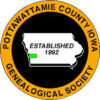From the 1882 & 1907 Pottawattamie County Histories
This is a full township of thirty-six sections. It is bounded on the north by Harrison County, east by Minden, south by Norwalk and west by Boomer townships. On June 10, 1872, a petition, signed by H. G. Fisher, George Remington, Fielding Steele and seventy-eight other citizens, resulted in the Board of Supervisors establishing the new township of Neola in township77, range 41, and township 77, range 42.
The principal city within the limits of the township is Neola. There was no special attraction to the area for early settlers until 1869 when the Chicago, Rock Island and Pacific Railroad was built and the town of Neola laid out on the lands owned by Messrs. Withrow, Wright and Allen.
The township is drained by the Mosquito and Pigeon creeks and their tributaries, nearly all of which are fed by living springs.
FIRST EVENTS:
- Settlers: G. W. Henderson who came from VanBuren County, Iowa, in March 1855. The next pioneers were Norman Abbott, Thomas Cellars, Mr. Hillsworth, William Tidwell, Joseph Balsley & Joseph Mecklin, John O’Brien, & Z. Remmington.
- Homes: 1868 — built by D. Little, who kept a store in the building. Then Mr. Kuhl built a harness shop, and Mr. Norris opened a blacksmith shop.
- Schools: The first term was taught in Neola in the winter of 1869-70 by Miss M. Webster, and the school was held in the building owned by David Tostevin. The second term was taught by Mrs. Doane in the loft of the blacksmith shop.
- Roads: the first roads were carved out by the early pioneers to suit their needs and convenience and it wasn’t until some time later that the first public road was actually opened in the township through the influence of Messrs. G. W. Henderson and Z. Remington. This road led from Section 5, Range 41, to the Ballard State Road, which ran to Council Bluffs. The length of the new road was about twenty-five miles.
Bridges: by 1882 there were three bridges across the two main streams in the township; one which crossed Pigeon Creek, and two across the Mosquito.
In 1882, the town of Neola received its charter, however many businesses and establishments had already been constructed. The first house was built by D. Little in about 1868, Mrs. J. W. Norris put up a small building, which was later owned by W. Graybill, and the Neola House Hotel claimed it’s heritage as being among the first buildings in the town and was erected by Charles Hamilton.
In 1870, a post office was erected by Mr. Duncan who also served as the first Postmaster. A new saloon opened and was operated by Daniel Flynn, and numerous additional businesses began to take form such as: two grain elevators, in 1878, constructed by Mr. Dillen, and Mr. C. Hamilton; H. Mendel, B. Riston, J. W. Butler, F. Riston, Eggleston Bros. and Bradley & Burton, dealers in General Merchandise; the hardware firms of Reichart Bros, C. M. Witt and C. B. Stone; Clothing Stores of Remington Bros. and C. M. Crippen; and various stock buyers; real estate agents; banks, livery stables, meat markets, millinery stores, etc. established by numerous early pioneers of the town.
Serving as physicians over the expanding population through the early years were: Dr. Barton, Dr. Vanness, Dr. Harvey, Dr. Todd and Dr. Lawrence. In 1881, Neola had one graded school. The building, which was erected at the cost of $3,000, was a frame structure 32 X 36 feet and two and one-half stories in height. About eighty-five pupils attended.
The rapidly expanding community could further boast of numerous society’s such as the Independent Order of Odd Fellows, and hosted two pioneer churches, one Catholic and one Presbyterian.
